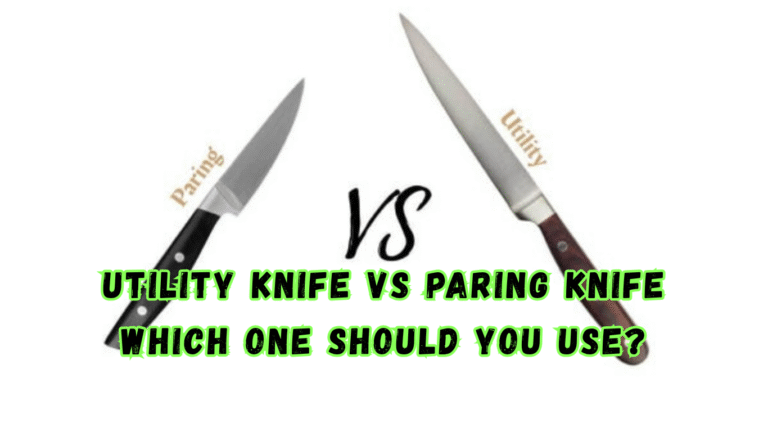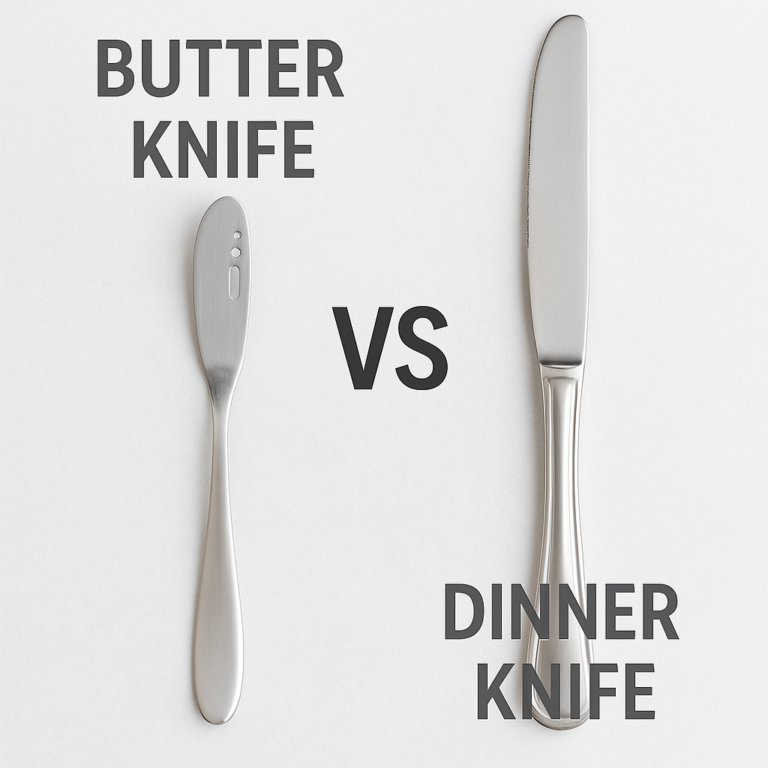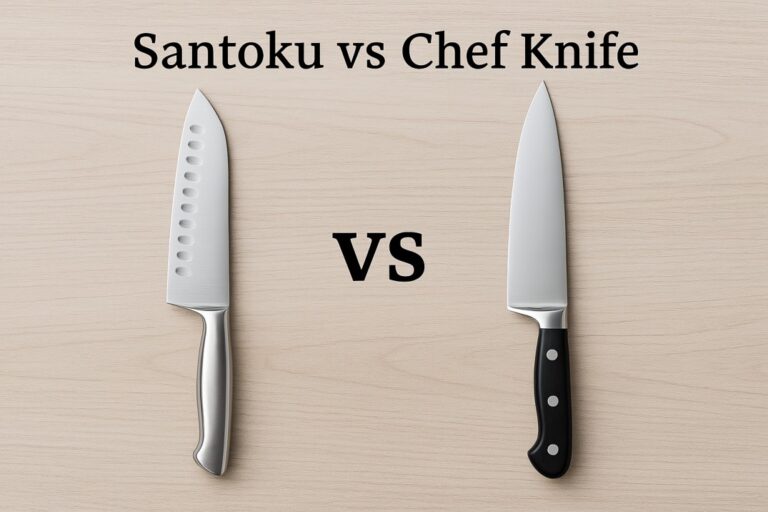Butcher Knife Vs Cleaver: Which is Best for Your Kitchen?
Are you standing in your kitchen, staring at your knife block, and wondering whether to reach for the butcher knife or the cleaver? You’re not alone.
Choosing the right tool can make your cooking experience smoother and more enjoyable. Imagine effortlessly slicing through meat or vegetables, saving time and energy. The decision between a butcher knife and a cleaver may seem minor, but it can have a significant impact on your culinary creations.
You’ll discover the key differences between these two essential tools and learn how to choose the perfect one for your cooking needs. By the end, you’ll feel more confident and equipped to tackle any recipe that comes your way. Dive in, and let’s slice through the confusion together.
Butcher Knife Traits
In the world of kitchen tools, understanding the difference between a butcher knife and a cleaver is essential. Both play critical roles in meat preparation, but serve different purposes. The butcher knife stands out with its unique traits, making it a favored tool among chefs and home cooks alike. Its design, usage, and maintenance set it apart, ensuring efficient and effective meat cutting.
Blade Design
The blade design of a butcher knife is distinct and purposeful. Typically, it features a long and curved blade that allows for smooth slicing through large pieces of meat. The curvature facilitates a rocking motion, enhancing precision and control. This characteristic sets it apart from other knives.
- Length: Usually ranges from 8 to 14 inches.
- Thickness: Thicker than most kitchen knives for added strength.
- Material: Often crafted from high-carbon stainless steel for durability.
A well-designed butcher knife ensures minimal resistance while cutting, making it easier to handle. The ergonomic handle provides a comfortable grip, reducing hand fatigue during extended use. This design makes it versatile for a wide range of cutting tasks.
Usage Scenarios
Butcher knives shine in specific scenarios where precision and power are needed. Their robust design makes them perfect for:
- Breaking down significant cuts of meat: Ideal for slicing through beef, pork, and lamb.
- Trimming fat: The sharp edge facilitates the easy removal of excess fat.
- Portioning: Perfect for dividing meat into portions or steaks.
While cleavers are used for chopping through bones, butcher knives excel in tasks requiring finesse. Their design allows for detailed work, such as removing silver skin from meat, without damaging the muscle fibers.
Maintenance Tips

Proper maintenance of a butcher knife ensures longevity and performance. Regular care keeps the blade sharp and the handle intact.
- Regular Sharpening: Use a whetstone or honing rod to maintain the edge.
- Cleaning: Wash by hand with mild detergent and dry immediately to prevent rust.
- Storage: Store the knife in a knife block or on a magnetic strip to protect the blade.
It’s crucial to avoid using a butcher knife on surfaces like stone or glass, as this can dull the blade. Regular inspection of the handle for cracks or wear helps in preventing accidents. Proper maintenance not only extends the knife’s life but also ensures safe and efficient use.
Cleaver Features
In the world of kitchen tools, the butcher knife and cleaver each serve unique roles. While both are essential for different culinary tasks, the cleaver stands out with its distinctive features. Understanding the cleaver’s characteristics can help you use it effectively in your cooking endeavors. From its blade size and shape to its specific uses, the cleaver is a versatile tool in any kitchen.
Blade Size And Shape
The cleaver’s blade is its most defining feature. It’s large, rectangular, and typically heavy, making it ideal for various cutting tasks. The blade’s size can vary, but it usually ranges from 6 to 12 inches in length. This size allows for decisive cutting actions, suitable for tougher ingredients.
The shape of the cleaver is designed for both precision and force. Its flat surface is perfect for crushing garlic or ginger, while the sharp edge can cut through bones with ease. The weight of the blade adds momentum, reducing the effort needed from your arm.
- Length: 6 to 12 inches
- Width: Broad, rectangular shape
- Material: High-carbon stainless steel for durability
A table summarizing typical cleaver blade dimensions might look like this:
| Feature | Description |
|---|---|
| Length | 6 to 12 inches |
| Width | Broad, rectangular |
| Weight | Heavy for momentum |
Best Uses
The cleaver excels in several kitchen tasks. Its primary purpose is for heavy-duty chopping. It’s often used to cut through bones and dense meat, making it a staple in many Asian kitchens.
Here are some of the best uses for a cleaver:
- Bone Cutting: Ideal for splitting bones in significant cuts of meat.
- Vegetable Chopping: The wide blade can handle large vegetables, such as cabbage or squash.
- Crushing: Use the flat side to crush garlic or ginger for enhanced flavor release.
Its versatility is unmatched. Whether you’re preparing a hearty stew or a delicate stir-fry, a cleaver can be your go-to tool. Its ability to handle both soft and hard ingredients makes it a favorite for many chefs.
Care And Handling

Proper care and handling of a cleaver are crucial for maintaining its performance and longevity. Always clean your cleaver immediately after use. This prevents residue from hardening, which can dull the blade.
Follow these steps for effective cleaver care:
- Cleaning: Wash with warm, soapy water and dry immediately.
- Sharpening: Regular sharpening keeps the blade effective. For optimal results, use a sharpening stone.
- Storage: Store in a knife block or magnetic strip to protect the blade.
Maintaining your cleaver not only extends its life but also ensures safety in the kitchen. A well-cared-for cleaver remains sharp and efficient, making your cooking tasks smoother and more enjoyable.
Performance Comparison
Choosing between a butcher knife and a cleaver often boils down to their performance in various tasks. Each has its unique strengths, making them suitable for specific cutting techniques and kitchen tasks. Understanding their performance can help in selecting the right tool for your culinary needs.
Cutting Techniques
Both the butcher knife and the cleaver excel in different cutting techniques. The butcher knife is designed for precision and control. Its sharp, pointed tip allows for intricate cuts. Here are some features:
- Slicing: Offers clean slices through meats and vegetables.
- Trimming: Perfect for removing fat and gristle.
On the other hand, the cleaver is known for its power. Its broad, heavy blade is ideal for chopping and splitting. Consider these aspects:
- Chopping: Easily cuts through bones and tough vegetables.
- Mincing: The flat blade allows for efficient mincing of herbs and garlic.
Here’s a simple comparison table:
| Technique | Butcher Knife | Cleaver |
|---|---|---|
| Slicing | Excellent | Good |
| Chopping | Moderate | Excellent |
Efficiency In Different Tasks
Efficiency varies between these tools, depending on the task. The butcher knife excels in tasks that require precision and accuracy. It’s lightweight and easy to handle, making it perfect for:
- Filleting fish
- Carving cooked meats
The cleaver, with its heavier build, is ideal for tasks demanding strength. Its robust design makes it perfect for:
- Breaking down significant cuts of meat
- Crushing garlic or ginger
Both knives have their niche, but the cleaver often takes the lead in tasks involving heavy-duty chopping. Here’s a task efficiency table:
| Task | Butcher Knife Efficiency | Cleaver Efficiency |
|---|---|---|
| Carving | High | Moderate |
| Breaking Bones | Low | High |
Versatility In The Kitchen
Versatility is a crucial factor in kitchen tools. The butcher knife is versatile in tasks requiring finesse. Its ability to switch from slicing vegetables to trimming meat makes it a valuable tool. Consider these points:
- Suitable for precision tasks
- Easy to clean and maintain
The cleaver’s versatility lies in its strength. It can be used for a wide range of tasks, from cutting through bones to crushing spices. Its heavy blade makes it adaptable to:
- Handling large vegetables
- Smashing and scooping ingredients
Both knives offer unique versatility, but the cleaver’s robustness gives it an edge in handling challenging tasks effortlessly.
Choosing The Right Tool

Choosing the right tool in the kitchen can make all the difference in your cooking experience. When it comes to meat preparation, the butcher knife and cleaver are two vital contenders. Each has its strengths, and understanding their differences can help you select the one that best suits your needs. Whether slicing through beef or chopping chicken bones, the right tool enhances efficiency and precision.
Types Of Meat
Different meats require different tools for optimal preparation. The butcher knife is versatile and ideal for a variety of meats. It excels at slicing through beef, pork, and lamb with ease. Its sharp edge and long blade make it an excellent choice for cutting steaks or trimming fat.
- Beef: A butcher knife is ideal for steaks and roasts.
- Pork: Efficient for chops and ribs.
- Lamb: Perfect for trimming and slicing.
On the other hand, the cleaver is designed for demanding tasks. It’s perfect for poultry and any meat with bones. Its heavy weight and wide blade make it ideal for chopping through bones and tough cuts.
| Tool | Best For |
|---|---|
| Butcher Knife | Slicing, trimming |
| Cleaver | Chopping bones, tough cuts |
Cooking Style
Your cooking style plays a significant role in determining whether to choose a butcher knife or a cleaver. If you prefer precision and fine cuts, a butcher knife is your best friend. It’s ideal for those who appreciate detailed work and a neat presentation.
- Grilling: Butcher knife for precise steak cuts.
- Roasting: Ideal for trimming fat and sinew.
For those who enjoy hearty meals and rustic dishes, a cleaver might be more suitable. It’s perfect for those who like cooking large pieces of meat or making stews.
- Stews: A Cleaver for chopping large chunks.
- Barbecue: Great for preparing ribs and bone-in cuts.
Personal Preference
Personal preference is key to selecting the right tool. Some cooks enjoy the balance and finesse of a butcher knife. Its ergonomic handle and sharp edge provide control and comfort, making it a favorite for many.
Others might prefer the heft and power of a cleaver. Its ability to break down bones and tough meat is unmatched. The cleaver’s design allows for easy handling of larger tasks.
Consider how each tool feels in your hand. The weight, balance, and grip can influence your choice. Some find the butcher knife’s lighter weight easier for longer tasks. Others appreciate the cleaver’s strength for challenging cuts.
Ultimately, the right choice depends on your cooking habits and comfort. Whether you’re a seasoned chef or a home cook, finding the right tool can enhance your kitchen experience.
Safety Tips
Handling butcher knives and cleavers safely is crucial for anyone working in the kitchen. Both tools are essential for cutting meat, but come with risks if not used properly. Understanding safety tips can significantly reduce the chance of accidents. Below, you’ll find practical advice on grip, cutting techniques, and storage solutions. These ensure safe usage and extend the life of your knives.
Proper Grip
Using the proper grip is key to controlling your knife safely. A secure grip provides stability, reducing the risk of slipping. Here are some pointers:
- Hold the handle firmly: A firm grip ensures control and precision.
- Thumb placement: Place your thumb on the side of the knife handle for better balance.
- Finger position: Curl your fingers around the handle, keeping them away from the blade.
Here’s a simple table to illustrate different grips:
| Grip Type | Description |
| Pinch Grip | Hold the handle like a hammer; it is suitable for heavy chopping. |
| Hammer Grip | Hold the handle like a hammer; suitable for heavy chopping. |
Cutting Techniques
Efficient cutting techniques prevent injury and ensure clean cuts. Here are some methods to consider:
- Chopping: Use a rocking motion to chop efficiently.
- Slicing: Slide the knife forward and back for thin slices.
- Cleaving: Apply a downward force to split bones.
Follow these steps for safer cutting:
- Secure your cutting surface: Ensure the chopping board doesn’t move.
- Position your knife: Keep the blade perpendicular to the board.
- Use controlled motions: Avoid fast, uncontrolled movements.
Storage Solutions
Proper storage helps keep knives sharp and reduces the risk of accidents. Consider the following solutions:
- Magnetic strips: Attach knives securely and keep them visible.
- Knife blocks: Provide slots for each knife, ensuring safe storage.
- Drawer inserts: Organize knives in drawers to keep blades covered.
Here’s a table comparing different storage options:
| Storage Option | Benefits |
|---|---|
| Magnetic Strip | Easy access and space-saving. |
| Knife Block | Protects knife edges; decorative. |
| Drawer Insert | Keeps knives hidden; safe. |
Select a storage solution that suits your kitchen space and usage patterns. Proper storage minimizes damage and ensures your knives are ready for use.
Frequently Asked Questions
A butcher knife has a long, curved blade for slicing meat. A cleaver has a heavy, rectangular blade for chopping.
A cleaver is better for cutting bones. Its heavy blade easily breaks through tough materials.
Yes, a butcher knife can be used to slice vegetables. Its sharp blade makes cutting easy and precise.
No, a cleaver is not suitable for delicate tasks. It’s too heavy and large for precision work.
Related Article: Santoku vs Chef Knife: Which One Should You Choose in 2025?
Conclusion
Choosing the right knife is crucial for practical cooking. The butcher knife cuts meat with precision. Perfect for slicing significant cuts. The cleaver excels at chopping through bones. Ideal for more challenging tasks. Both knives have strengths. Think about what you need most.
Are you slicing or chopping? Consider your cooking style. Both knives belong in the kitchen. Each serves its purpose well. Select the one that best fits your needs. They make cooking easier. Investing in quality knives is smart. Enjoy preparing meals with the right tools.
Cooking becomes more enjoyable. Make your choice today. Your kitchen will thank you.







